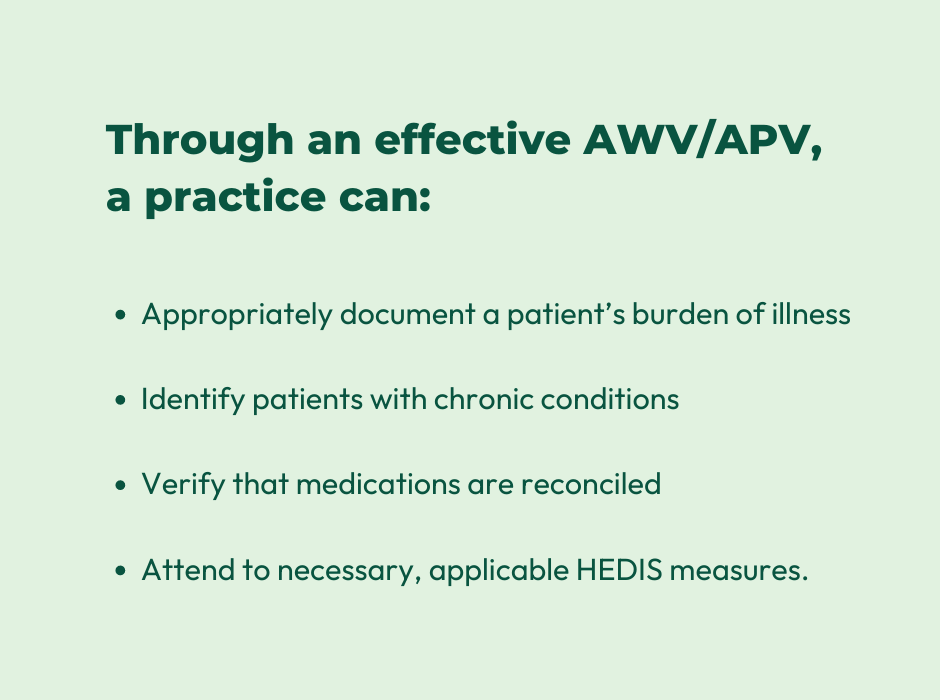Annual Roadsigns at the Intersection
As the first entry in this blog series states [Intersection Blog#1], there are activities a physician or provider can perform in the office that benefit the patient and the practice regardless of one’s stance in fee-for-service (FFS) or value-based care (VBC) practice models. This intersection carries even more importance when one considers that, even in many successful VBC organizations, physician compensation still lags in the FFS and production world. The activities to be discussed can motivate the front-line doc from a production perspective while benefitting the organization from a VBC perspective.
The first activities we’ll explore will be the combinations of Annual Wellness visit for Medicare (AWV), Annual Preventive Visits for commercial plans (APV), and Annual Preventive Physical Exams for Medicare advantage plans (APPE).
From the FFS perspective all these yearly patient evaluations add revenue at a relatively higher rate than a typical office visit. A Medicare AWV generates the same work RVU rate as a moderate level visit, 99214, at 1.92. A well-planned and executed AWV can move quickly in an office setting. Since much of the data-gathering can be done by ancillary staff in the office, the amount of time needed by the physician or provider to get the same information from and benefit to the patient can be less than with a 99214.
Additionally, when coded properly, regular office visits can often be billed at the same time as an AWV. This is helpful when a regular office visit gets converted to an AWV (a function of a well-oiled daily huddle by the office staff). The benefits of the AWV can be realized, and the patient can get their acute need met.
Annual wellness/preventative visits are well-known in the VBC world as the foundation of medical management. Organizations mature in the VBC space recognize the multi-pronged value-producing activities of a well-performed AWV/APV.
Through an effective AWV/APV, a practice can:
● Appropriately document a patient’s burden of illness
● Identify patients with chronic conditions
● Verify that medications are reconciled
● Attend to necessary, applicable HEDIS measures.
Medicare calculates what the potential cost of care for each patient will be for the current year based on a patient’s burden of illness. A conglomeration of that number for all patients managed by a plan or practice (as in the case of an Accountable Care Organization - ACO) is used to determine the benchmark payment for that group of patients. When at full risk (like a Medicare Advantage plan or a mature physician practice), this is the money received as premium to deliver care to those patients. In shared savings models (like ACOs), this is the dollar amount needed to get under to realize any savings revenue. Appropriate documentation of a patient’s burden of illness can potentially impact one’s benchmark, increasing the premium dollars available to care for patient and/or raise the opportunity for shared savings.
Identifying patients with chronic conditions allows for optimization of conditions like depression, hypertension (HTN), or diabetes (DM). Once identified, an individualized plan of care can be initiated to enhance their care and improve their outcomes. Healthier patients are happier patients, and this also means improved savings revenue for the organization.
Medication reconciliation is an oft-overlooked practice in medicine but is an activity that greatly benefits patient care. Reviewing medicines with a patient is a simple step that can keep patients out of the ED and hospital by ensuring they’re on all the necessary meds and only those meds.
The NCQA developed HEDIS measures as a way of measuring quality in medicine. While this definition of quality can be a source of philosophical argument, the bottom-line is this: HEDIS measure closure can lead to improved patient care. We’ll go into more detail on HEDIS in another blog in this series. The short story is that screening and preventative HEDIS measures can help avoid acute and chronic health issues or catch them early when the conditions are more impactable. Likewise, meeting the goals for management of chronic conditions like hypertension or diabetes leads to improved patient health, well-being, and outcomes – and savings in the cost of care. As a bonus, in many VBC contracts, closure of HEDIS measures can lead to quality bonus revenue from plans or open the gates to shared savings.
Annual Preventive Physical Exams (APPE), augment the findings of an AWV/APV utilizing a well-established tool in the physician’s toolbox – patient examination. A well-done exam can uncover early signs of chronic conditions and their poor control or discover other issues in need of addressing, such as suspicious skin lesions. The same benefits as outlined above apply. These exams are covered by most Medicare Advantage Plans, generating FFS revenue in addition to the VBC benefits.
When done well, these activities benefit patients, physicians, practices, and payers for a quadruple win. Patients fare better, physicians are more “productive”, and entities on the hook for health care costs benefit. Next up … HEDIS.
